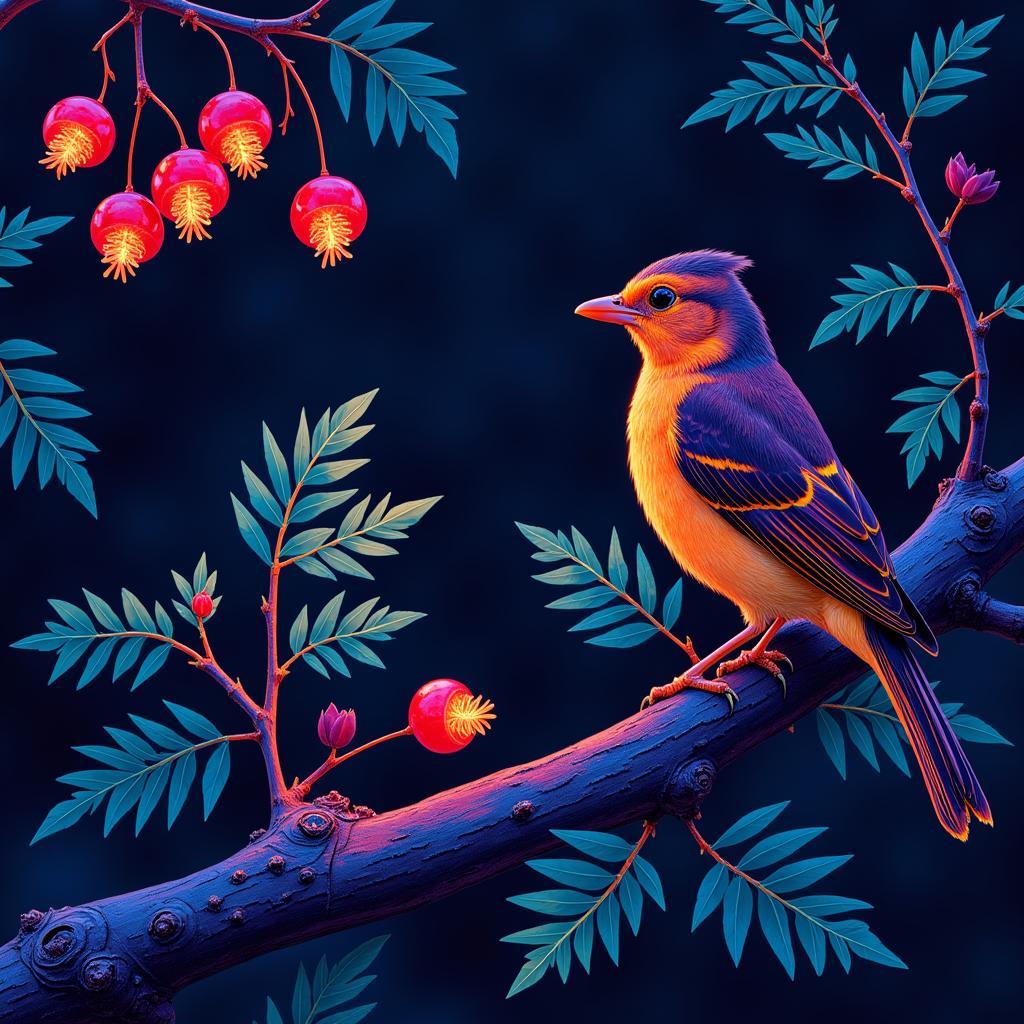Birds and their vibrant plumage have captivated humans for centuries. We often wonder, do birds see color the way we do? The answer is a resounding yes, and in fact, their color vision is often far superior to our own. Let’s explore the fascinating world of avian color perception.
Do you ever wonder about the meaning of flower colors? This seemingly simple question unveils a complex world of communication between plants and pollinators like birds. Birds play a crucial role in pollination, and their ability to see a wide spectrum of colors helps them locate nectar-rich flowers.
Seeing the World Through Bird’s Eyes: A Spectrum of Colors
Birds don’t just see the colors we see; they perceive a much broader range, including ultraviolet (UV) light, which is invisible to the human eye. This expanded spectrum allows them to see a level of detail and nuance in color that we can only imagine. For instance, a seemingly dull brown bird to us might display vibrant UV patterns that are crucial for mate selection and communication within their species. Their ability to see UV light also helps them identify ripe fruits and berries against green foliage, enhancing their foraging efficiency.
 Bird Seeing UV Light on Berries
Bird Seeing UV Light on Berries
The Science Behind Avian Color Vision
The secret to birds’ exceptional color vision lies within their eyes. Like humans, birds have cone cells in their retinas that are responsible for color detection. However, unlike humans who have three types of cones (red, green, and blue), most birds have four types, adding a UV-sensitive cone to the mix. This additional cone significantly expands their visible spectrum. Furthermore, birds also possess oil droplets within their cone cells that act as color filters, further refining their color perception.
You might be surprised to learn that even dinosaurs, the ancestors of birds, likely possessed complex color vision. The question of what color are T rex remains a mystery, but current research suggests that they may have had vibrant coloration, which could have played a role in camouflage, mate attraction, or even intimidation.
How Birds Use Color: From Finding Food to Attracting Mates
Color plays a vital role in various aspects of a bird’s life. It’s essential for:
- Foraging: Locating ripe fruits, seeds, and insects.
- Mate Selection: Choosing a healthy and genetically fit partner.
- Communication: Signaling dominance, submission, or alarm.
- Camouflage: Blending into their surroundings to avoid predators.
- Navigation: Some evidence suggests birds may use UV light for navigation.
Have you ever heard the vibrant song “De Colores in English Lyrics”? While the lyrics don’t directly relate to bird vision, the song celebrates the beauty of colors in nature, a beauty that birds experience in a far richer way than we do.
Expert Insights on Avian Color Vision
Dr. Ava Chen, an ornithologist specializing in avian vision, notes, “Birds’ ability to see UV light opens up a whole new dimension to their visual world. It allows them to see patterns and details that are completely invisible to us.” Professor Robert Klein, an evolutionary biologist, adds, “The evolution of tetrachromatic vision in birds is a remarkable adaptation that has played a key role in their survival and diversification.”
Conclusion: Appreciating the Colorful World of Birds
Do birds see color? Absolutely! Their intricate and complex color vision allows them to experience the world in a way we can only begin to comprehend. Understanding how birds see color not only provides fascinating insights into their lives but also deepens our appreciation for the vibrant beauty of the natural world. If you are curious about birds’ color vision, you might also be interested in learning about where is Falcon Colorado, a haven for bird watchers.
FAQ
- What is tetrachromacy? Tetrachromacy is the ability to see colors across a wider spectrum, including ultraviolet light, due to possessing four types of cone cells in the eyes.
- How does UV vision benefit birds? UV vision helps birds find food, select mates, communicate, and possibly navigate.
- Do all birds have the same color vision? While most birds have tetrachromatic vision, there are some variations between species.
- Can humans see UV light? No, humans cannot see UV light.
- How do oil droplets in bird eyes enhance color vision? Oil droplets act as filters, refining the colors perceived by each cone cell.
- What are some examples of how birds use color in their daily lives? Birds use color to find ripe berries, choose mates with vibrant plumage, and signal to other birds.
- Why is it important to understand bird vision? Understanding bird vision helps us appreciate the complexity of the natural world and the adaptations that allow birds to thrive.
Can birds see colors? Yes they can! Want to know more about birds and their colorful world? Check out this article that discusses the meaning of flower colors, an important aspect of how birds interact with their environment.
Need help with color?
For all your color needs and expert advice on transforming your space, contact us:
Phone: 0373298888
Email: [email protected]
Address: 86 Cầu Giấy, Hà Nội
Our 24/7 customer service team is ready to assist you.

